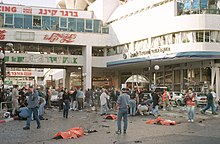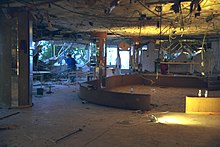Palestinian suicide attacks
Attacks occurred at various locations, including shopping centers, public buses, transit stations, cafes, nightclubs, and restaurants,[4] According to a 2006 study from the University of Haifa, only a few of the bombings targeted military objectives.
[15] Suicide bombings in the 1990s and 2000s had an unexpected and severe impact on Israel's home front,[16] profoundly affecting Israeli society and hardening attitudes towards Palestinians as potential peace partners in a two-state solution.
[19][7] This tactic has since been employed in countries such as India, Indonesia, Iran, Iraq, Israel, Kenya, Lebanon, Pakistan, Palestine, Russian, Saudi Arabia, Sri Lanka, Turkey, the UK, the US, and Yemen.
[38] The first major attack by Hamas occurred on April 13, 1994, at the Hadera bus station suicide bombing, killing five people,[37] as retribution for the Cave of the Patriarchs massacre by Baruch Goldstein in February.
[48] Under the leadership of Secretary General Ahmad Sa'adat (2001 to present),[49] the PFLP were responsible for several notable incidents, including the assassination of Israeli Minister of Tourism Rehavam Ze'evi.
[53] On 14 August 2009, the leader of Jund Ansar Allah, Abdel Latif Moussa, unexpectedly declared the creation of the Islamic emirate in the Gaza Strip to his armed followers at the Ibn Taymiyya mosque in Rafah after the Friday prayer.
The BBC and The Jerusalem Post reported that according to Hamas, when they reached the positions of Moussa and Abu Abdullah al Suri, the two men detonated explosive vests.
[6][71][72] Individual motivations for becoming a suicide bomber may stem from various factors, including the desire to attain expected rewards in the afterlife, economic or social benefits for family members, the influence of a widespread culture of martyrdom, the struggle for national liberation, a drive to seek revenge for the death or injury of a loved one, or a response to the real or perceived humiliation associated with Israeli occupation.
[12] This belief is echoed in statements by figures like the mufti of Jerusalem, Ekrima Sa'id Sabri, and Hamas leader Ismail Haniyeh, who have contrasted the Muslim willingness to die with the Jewish preference for life.
[79] Some Islamic theologians and jurists, including Yusuf al-Qaradawi, who hosted the weekly TV show Sharia and Life on Al-Jazeera, have condemned terrorist attacks by Al-Qaeda and similar groups, but not Palestinian suicide bombings against Israeli civilians.
[84] This financial support, combined with the elevated social status bestowed upon the family due to the martyrdom of their member, leads to significant improvements in their living conditions and public standing.
[85] Claude Berrebi of the RAND Corporation found that nearly 60% of suicide bombers recruited by Hamas and Islamic Jihad had education beyond high school, whereas less than 15% of the general adult male Palestinian population did.
[86] Many Palestinian suicide bombers are motivated by nationalist sentiments, joining groups like Hamas, PIJ, and Fatah to fight perceived injustices and defend their land against what they see as encroachment by the "Zionist entity".
[90] Students from middle-class backgrounds at An-Najah National University, a group with a high representation among suicide bombers in the Palestinian territories, reportedly said that "Martyrs give us dignity to free ourselves".
This reflects the widespread sentiment among Palestinians that daily life in the occupied territories is marked by fear, despair, and constant humiliation, which provoke strong sense of justice and a desire for revenge.
[90] Cognitive psychology studies on Palestinians living in the West Bank and Gaza report that "members of different militant groups often attribute their own violent acts to personal or collective humiliation experienced at the hands of their oppressors".
[79] Interviews conducted by Brym and Araj with the families and friends of Palestinian suicide bombers suggest that these individuals do not exhibit higher levels of depression than what is typically observed in the general population.
[98][99][100] While religion can be used as a recruitment tool, the main motivation is the strategic military objectives of terrorist organisations: "There is strong evidence that Islamic fundamentalism has not been the driving force behind Palestinian suicide terrorism".
He believes these groups thought the bombings would speed up Israel's withdrawal from Gaza and the West Bank, an assessment shared by other observers and Israeli leaders, which ultimately proved correct.
[116] Recruitment for suicide missions by Palestinians groups generally involves a selective process where potential candidates are chosen based on their religious commitment, loyalty, and ability to maintain secrecy.
The planning is divided into specific roles: organizational leadership sets strategic goals, operators manage the selection and preparation of bombers, and aides handle material acquisition and logistical support.
[123][125] Several scholars observed that the recruitment of female suicide bombers by Palestinian groups was driven by the need to bypass Israeli security measures and checkpoint barriers.
[14] The culture of martyrdom is deeply embedded, evident in various forms including naming sports tournaments after suicide bombers or featuring dramas about figures like the bomb maker Yahya Ayyash.
[122] Following a surge of suicide bombings in early 1996, the Israeli government established an extensive and costly security system to protect borders, roads, and key installations.
[16] Despite Operation Defensive Shield's success in degrading terrorist capabilities, attacks continued, leading to increased public pressure for the construction of the West Bank barrier, which began in 2002.
[17] The 1990s saw Hamas using suicide bombings to disrupt the Oslo Accords and the peace process, aiming to weaken the Palestine Liberation Organization (PLO) and polarize Israeli politics.
Consequently, Hamas adopted rocket fire against Israeli urban centers as a primary strategy, leading to substantial disruption and casualties in southern Israel and posing an ongoing threat to a larger civilian population.
[143] Directed by Hany Abu-Assad, the film follows two Palestinian friends recruited for a suicide bombing mission in Tel Aviv, exploring their motivations, doubts and the moral complexities of their actions.
The film rejects the romantic notion of heroism and sacrifice: both main characters are disillusioned young men, trapped and suffocated by the occupation, far from the heroic figure of the martyr.
According to Sayed Kashua, "By introducing the terrorist group, Fauda allows viewers in the United States and Europe to see Al-Makdasi as their own enemy — and revel in the heroism of the brave Israelis who protect them from the barbarians".








